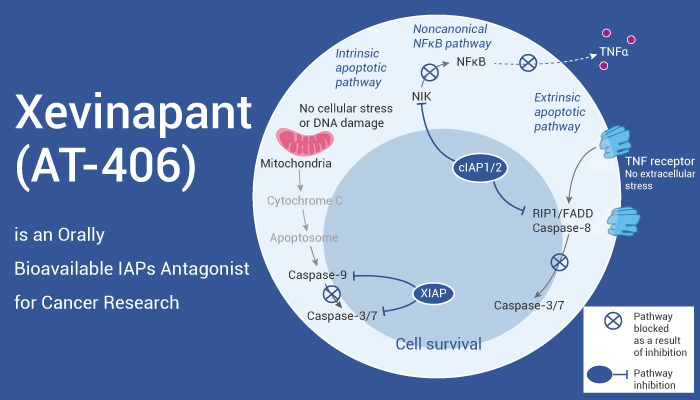Apoptosis is a cellular process critical to the normal development and homeostasis of multicellular organisms. Therefore, dysfunction of the apoptosis machinery has been linked to many human diseases. These diseases including cancer, inflammation and neurological conditions. In addition, defects in the apoptosis machinery confer on cancer cells resistance to therapeutic agents and are known to compromise current anticancer therapies, leading ultimately to their failure. Hence, avoidance of apoptosis is a hallmark of human cancer and targeting key apoptosis regulators with the goal of overcoming the evasion of apoptosis by tumor cells is an exciting therapeutic strategy for the treatment of human cancer. In addition, IAPs are a family of proteins that inhibit apoptosis or programmed cell death and are often overexpressed in cancer cells, contributing to theirresistance to chemotherapy and radiation therapy (RT). Thence, we will introduce a IAPs antagonist-Xevinapant (AT-406; Debio 1143; SM-406).

Xevinapant is an orally active smac mimetic and IAPs antagonist.
In vitro, Xevinapant binds to XIAP, cIAP1, and cIAP2 proteins with Ki values of 66.4, 1.9, and 5.1 nM, respectively. Moreover, Xevinapant effectively inhibits lots of human cancer cell lines and shows IC50 of 144 and 142 nM in MDA-MB-231 cell and SK-OV-3 ovarian cell. Besides, Xevinapant with low toxicity against normal-like human breast epithelial MCF-12F cells and primary human normal prostate epithelial cells.
Moreover, Xevinapant (30 and 100 mg/kg; p.o.; 5 days a week for 2 weeks) inhibits tumor growth and completely inhibits tumor growth during the treatment with 100 mg/kg, in SCID mice bearing MDA-MB-231 xenograft tumors.
Moreover, a high proportion of head and neck squamous cell carcinomas (HNSCCs) have genomic alterations in IAP pathways. This genomic alterations results in the dysregulation of cell death pathways and rendering them susceptible to IAP antagonist therapy.
All in all, Xevinapant is a promising IAPs antagonist for cancer research.
Reference:
[1] Cai Q, et al. J Med Chem. 2011 Apr 28;54(8):2714-26.
[2] Kansal V, et al. Cancer Med. 2023 Jul;12(13):13958-13965.